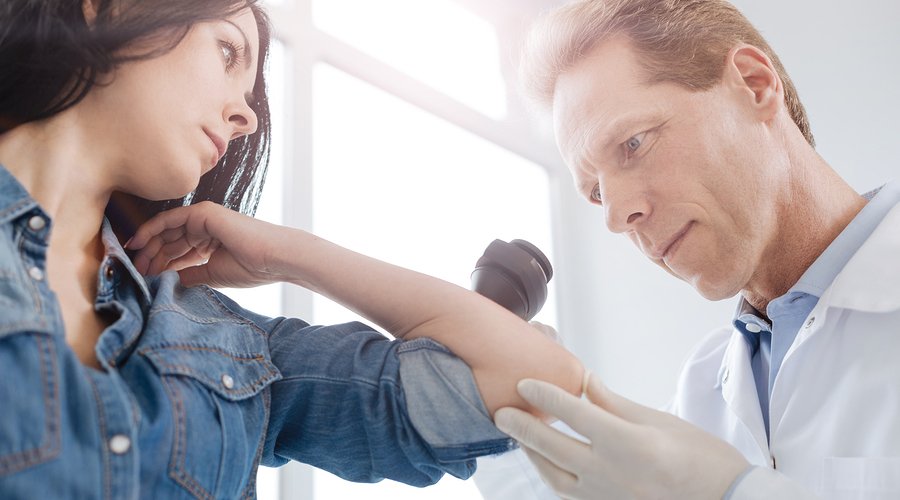Now that summer has come and gone, you may be packing away your beach supplies and starting to shop for sweaters and boots. But before you switch gears completely to a fall mindset, give your skin a thorough examination after summer’s extra sun exposure. And while we all are aware of the necessity of checking our moles for changes that might signal the possibility of cancer, new research suggests that we need to be much more conscious of any changes to the rest of our skin if we want to catch any developing melanomas at an early stage.
The study, which was conducted at the Arcispedale Santa Maria Nuova at Reggio Emilia in Italy, found that it is actually more likely for a melanoma to form on lesion-free skin than in an existing mole, which is contrary to what many of us have learned through the years about skin cancer risks.1 Pampena, Riccardo; et al. “A meta-analysis of nevus-associated melanoma: Prevalence and practical implications.” Journal of the American Academy of Dermatology. 29 August 2017. Accessed 3 September 2017. http://www.jaad.org/article/S0190-9622(17)32051-0/fulltext. These results are based on a comprehensive review of 38 earlier investigations involving cases of more than 20,000 melanomas.
By analyzing such a large number of medical records, the researchers were able to obtain a good overall picture of melanoma development. They discovered that just 29 percent of the melanomas started in moles that had been present before and a whopping 71 percent arose independent of any moles, which was an unexpected outcome. Many skin cancer awareness campaigns note the specifics to look for when examining moles, such as changes in color, border irregularities, and an asymmetrical appearance, which is helpful, but far from the whole story of what we should be concentrating on when it comes to skin cancer.
And melanoma is among the most dangerous forms of skin cancer. It strikes far fewer people than basal cell carcinoma, squamous cell carcinoma, and other skin cancers, but it is often much more deadly, and unfortunately it is on the rise. According to the Skin Cancer Foundation, approximately 76,380 cases of melanoma were diagnosed in 2016, and an estimated 10,130 people die due to melanoma in the United States annually.
To protect yourself from melanoma and other types of skin cancer, it’s essential to get to know your skin very well. That means regular checks of the skin all over your body, not just looking over any moles you may have. And these self-checks should be performed monthly in order to catch any new lesions or differences to existing moles quickly. For those parts of your body that you probably can’t view closely even with a three-way mirror, such as your back and posterior, ask your significant other or a close friend to take on the task.
If you note anything different from previous body checks, you should visit a dermatologist as soon as possible. They will not only examine the area in question, but they will biopsy a sample of the skin to test for malignancy. If the result is positive for cancer, you might need treatment. However the stage at which it is caught can make a huge difference in prognosis, and if skin cancer is found early enough, the biopsy might even remove all abnormal cells.
It’s a good idea to see a dermatologist annually even if you don’t notice any changes in your skin simply because they are well versed in what is normal versus suspicious and include photos to better compare changes. And of course those appointments should be more frequent if you have received any prior diagnoses of skin cancer or you are considered high risk, which includes a family history of skin cancer, very fair skin color or red hair, and having a large number of moles.
Just because summer is over doesn’t mean we should be putting away our hats and sunblock, either. Aside from protecting yourself with regular skin checks, it’s essential to avoid too much sun exposure all year long. So apply sunblock to all skin that’s showing if you’re going to be outside for longer than 20 or 30 minutes and wear a hat that shields your face when spending time outdoors. A little bit of prevention can go a long way when it comes to skin cancer.
PS: but remember, there is a balance required here. At the same time that you need to avoid skin damage and melanoma, you also want to make sure you get enough safe sun exposure every day to keep your vitamin D levels maxed out.
References
| ↑1 | Pampena, Riccardo; et al. “A meta-analysis of nevus-associated melanoma: Prevalence and practical implications.” Journal of the American Academy of Dermatology. 29 August 2017. Accessed 3 September 2017. http://www.jaad.org/article/S0190-9622(17)32051-0/fulltext. |
|---|












Even if the study results
Even if the study results hold up after replication, the fact is that moles represent a tiny percentage of one’s skin surface area. Their contribution to melanoma is far in excess of that.
All moles should be removed. Medically, they are TUMORS. While most of them will not turn cancerous, no test is certain. Fortunately, they can be removed quickly, inexpensively, and with little or no pain.
They can be removed by freezing, a simple flick of a blade, or (most easily and at home) by application of eggplant-derived compounds that dissolve abnormal skin, while leaving normal skin alone.
So sun blockers are healthy
So sun blockers are healthy for us? When did that happen?
sun block? really? sunblock?
sun block? really? sunblock? it is sunblock that is causing the rise in skin cancer.
Titanium Dioxide toxicity can
Titanium Dioxide toxicity can be found searching MSDS data base site. It is used in artists paints, etc. & not for ingestion which includes the skin. Some health supplements use it to coat capsules.
Just curious what the “egg
Just curious what the “egg plant-derived compounds are mention in above “mole” article is?
They can be removed by freezing, a simple flick of a blade, or (most easily and at home) by application of eggplant-derived compounds that dissolve abnormal skin, while leaving normal skin alone.
Thank you
Ann
I don’t see “egg plant
I don’t see “egg plant-derived compounds” in the article, not sure where you read that.